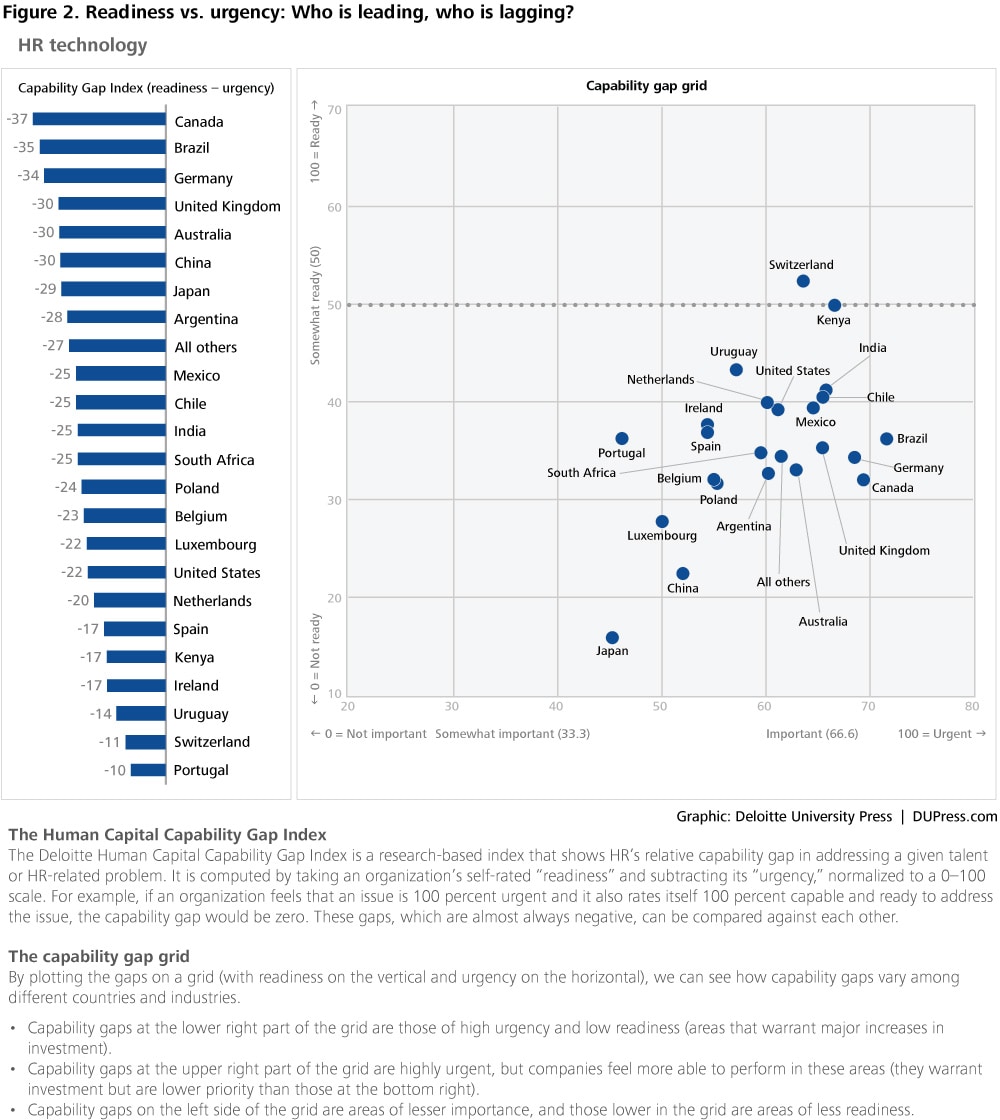Race to the cloud has been saved

Race to the cloud Integrate talent, HR, and business technologies
08 March 2014
Cloud-based HR technology promises to integrate people systems, enable learning and talent management, and reengineer recruiting. But massive adoption of new software is harder than it seems.
- Companies are rapidly moving away from legacy systems to implement a new breed of highly integrated, cloud-based talent and HR systems.
- Two-thirds of our global survey respondents say that HR technologies are “urgent” or “important,” yet 56 percent report that their companies are either not considering updating their systems or have no definitive plans to do so.
- Companies that adopt cloud-based talent solutions ahead of their peers may gain an advantage in driving employee satisfaction, engagement, capability development, and performance—and generating data for the emerging wave of talent analytics.
Explore the report findings
Launch the interactive trends dashboardCreate and download a custom PDF of the Human Capital Trends 2014 report.
The HR technology marketplace is one of the fastest-growing areas of business. The market for integrated talent management systems will reach nearly $5 billion in 2014, and the market for human resources management systems (HRMS) is now over $12 billion.1
Why the dynamic growth?
Today, perhaps for the first time in nearly 20 years, cloud computing has brought vendors together around a common set of technologies, making solutions more integrated, easier to use, and easier to deploy than ever. Organizations can select and implement a wide range of HRMS and talent management tools in record time, eliminating the need to build an enormous IT team to install, configure, and customize software.
Interestingly, however, given the size of the HR technology market, less than half of our global survey respondents said that they were in the process of updating their HR and talent systems, and over 56 percent of respondents reported they have no definitive plans or no plans in this area (figure 1).
Companies that update their HR and talent systems are using technology to change the organization, rather than making technology the change in itself. Research suggests there are four key factors that determine success—or failure—for companies moving to cloud-based HR technology platforms: integration, ease of use, industrial strength, and implementation and support.2
Shifting from legacy silos to a single integrated system
The average large company has seven HR systems of record.3 These systems typically do not communicate well, if at all—a problem that has been frustrating HR and business leaders for years.
A 2012 global survey found that two-thirds of companies are willing to sacrifice technical features for a single-vendor or highly integrated solution.4 Today, implementing integrated HR systems is increasingly within reach.
Most of the major ERP providers (Oracle, SAP, Workday, ADP, Infor, and NetSuite) are building highly integrated end-to-end HR, payroll, and talent management platforms. In 2014, these technology companies will likely focus heavily on incorporating analytics platforms, mobile interfaces, and better recruiting systems.
Companies across the world recognize the importance of implementing these kinds of systems, but almost all are unprepared to do so. With the exception of companies in just a few countries—for example, Switzerland—most are far behind in the race to replace legacy HR technologies with integrated cloud-based solutions (figure 2).
Mobility drives ease of use and impact
The ultimate success of HR software is directly dependent on its adoption by users. Embracing mobile access is an essential feature of any easy-to-use technology platform. Organizations tell us that upwards of 40 percent of job applications now come via mobile devices.5 Employees want mobile access for time and expense reporting, employee directory, knowledge sharing, and other HR applications.
Unfortunately, many employers are currently unable to provide such tools. A solid majority (60 percent) of global survey respondents acknowledge that their organizations have not implemented HR technology that is “up to date, easy to use, and mobile-accessible” (figure 3).
HR applications benefit by having a mobile strategy, both to promote ease of use and increase business impact. Today’s HR software is not only a system of record; it is a “system of engagement.”6 Employees and managers use these systems for everyday support, including collaboration, learning, goal setting, and expertise sharing. When companies roll these systems out, they are creating a new way of working for most of the organization.
Providing industrial-strength implementation and support
HR technology is complex and offers thousands of features and applications.
While the cloud has made system installation easier, companies still need a support team behind them. Vendors, for example, can now upgrade systems automatically every three to six months, rather than waiting for corporate IT departments to plan updates. Companies need a process to manage this change, along with processes for data quality and error handling. Moreover, it is increasingly important to avoid costly customization.
Data-driven decision making
HR systems now have “embedded analytics”—dashboards that instantly show rankings, ratings, and graphical views of people-related data in two-dimensional form. Therefore, an important step in any new systems project is to define data standards and establish a data dictionary.7 When these standards are established early, the results can be groundbreaking, providing companies with data to inform and drive decision making.
In addition to considering data issues during system implementation, companies should also train HR business partners and line managers to use the new data made available to them. Companies should build simpler dashboards and graphical tools that make data easy to use and actionable. Line managers, for example, do not need to be trained analysts or statisticians, but they need to understand how to access data that can help them make better business decisions.
Today’s HR software is not only a system of record; it is a “system of engagement.”
Lessons from the front lines
USING THE CLOUD TO SIMPLIFY DATA MANAGEMENT
Seeking to replace redundant manual processes and manage its global workforce more efficiently, cosmetics and beauty products leader Elizabeth Arden decided to move its HR technology to the cloud. In 2011, the company selected long-time partner Oracle to deploy the Oracle Fusion HCM cloud-based solution.
The rollout was planned in phases. Since the company’s non-US businesses were expected to grow faster than US operations and had significantly fewer capabilities to manage their workforce, Elizabeth Arden planned a phased deployment. Phase 1 of the program focused on its largest and most complex non-US markets—the United Kingdom and Switzerland. Phase 2 continued the program’s global rollout to the remaining European and Asian countries. Phase 3 will focus on the United States.
The scope of the project was quite broad. It included implementing a global set of “good practice” HR processes and creating a single global source for employee data. Workforce reporting and analytics tools were also built into the system.
The solution streamlines core human capital and talent management functions such as performance, compensation, and employee objectives and goals. HR can now easily extract information and upload it to existing payroll systems, while an automated annual compensation process allows for more consistent and equitable compensation practices, at both the global and the local level. Employees can now enter and access their personal information easily, and managers enjoy faster, more consistent data management processes.8
Users describe the new system, MyHRDoor, as “employee-friendly” and “ready to use” while also providing more robust reporting and analytics capabilities for management. The end result is less paperwork, much simpler business processes, and more reporting at the user’s fingertips. As a result of this move to the cloud, Elizabeth Arden has significantly improved its workforce reporting and analytics capabilities, enabling the company to dramatically raise its ability to manage a variety of HR responsibilities critical for today’s global businesses—from increasing global mobility to more effective performance management and succession planning.
Equally important, the solution can constantly evolve to meet the company’s changing needs. New Oracle upgrades can be uploaded easily every few months, delivering greater functionality with every new release. The process of applying upgrades to cloud solutions is significantly less time-consuming than for traditional ERP technology, and is a critical differentiator for cloud solutions.
For Elizabeth Arden, the ease of use, greater functionality, and sharply heightened analytics capability mean that its cloud-based solution reaches beyond technology and process improvement to serve as a catalyst for broader organizational and cultural change.
Where companies can start
If cloud-based talent solutions are so powerful, what is holding some companies back from adopting them? Mainly, it’s coming to the realization that cloud solutions are now mature enough to make a real difference—and mustering the activation energy to get started. Potential starting points include:
- Be prepared to sprint, but start with a plan: Take advantage of the shorter time frames needed to implement cloud-based HR and talent technologies. Develop a game plan in which process improvement and data and analytics are priorities that guide the selection and implementation process.
- Align with critical and emerging business goals and metrics: Ensure that HR has a strong understanding of the organization’s emerging and core business issues and key metrics and performance indicators to determine what HR-related data will be most useful in aligning and driving business performance.
- Assign a joint HR/business/IT leadership team: Create a team to promote active cooperation and interaction among HR specialists, as well as between business and HR, to ensure effective integration strategies, security, mobile access standards, and vendor selection.
- Refresh the HR service delivery model: Use the opportunity provided by the implementation of new technology to rethink how HR serves users, how it will support self-service technology, and how local business partners will leverage the system.
- Promote broad adoption: Bring together all stakeholders early to encourage widespread adoption of the system once it is rolled out. Make the system easy to use for both HR managers and employees.
Bottom line
The race to the cloud presents an opportunity for HR transformation. A new cloud-based platform allows companies to consolidate legacy systems and dramatically improve decision making. These systems also help redefine the role of HR, set up a more scalable service delivery model, and improve the effectiveness of HR business partners. Today’s integrated HR platforms are not just systems of record, but “systems of engagement.” When adopted widely, these platforms enable dramatic improvements in productivity, capability development, collaboration, and data-driven decision making.
© 2021. See Terms of Use for more information.





